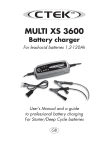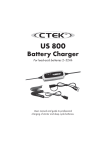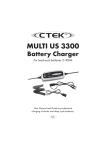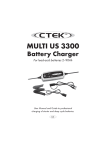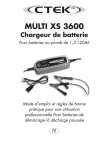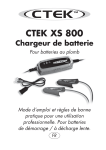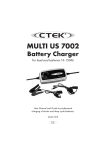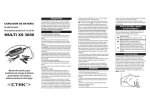Download CTEK XC 800 User manual
Transcript
CTEK XC 800 Battery charger For lead-acid batteries 1.2–100Ah User Manual and guide to professional battery charging for Starter and Deep Cycle batteries. GB INTRODUCTION Congratulations on your purchase of your new professional CTEK XC 800 Switch Mode Charger with Pulse Maintenance. CTEK XC 800 is a member of a family of professional chargers from CTEK Sweden AB. It represents the state-of-the-art technology for battery charging. A CTEK XC 800 will prolong the lifetime of your battery. Read this user manual and follow the instructions carefully before using the charger. SAFETY • The charger is designed to charge 6V lead-acid batteries from 1.2 to 32Ah. However, the charger can maintain batteries up to 100Ah. Do not use the charger for any other purpose. • Use safety glasses and turn your head away when connecting or disconnecting a battery. • Battery acid is corosive. Rinse immediately with water if acid comes into contact with skin or eyes. Seek medical advice. • Make sure that the cable is not being pinched or in contact with warm surfaces or sharp edges. • While charging, a battery can emit explosive gases, so it is important to avoid sparks in the immediate area. • Always provide for proper ventilation during charging. • Avoid covering the charger. • Make sure that the electrical cable does not come into contact with water. • Never charge a frozen battery. • Never charge a damaged battery. • Do not place the charger on the battery while charging. • The electrical connection must fulfil the national heavy current requirements. • Check the cabling in the charger before use. Make sure there are no cracks in the cabling or in the protective covering. A charger with damaged cables may not be used. • Always check that the charger has gone over to maintenance charging mode before leaving the charger unattended and connected for long periods. If the charger had not gone over to maintenance charging within 3 days, this is an indication of a problem. In this case the charger must be disconnected manually. • All batteries fail sooner or later. A battery that fails during charging is normally taken care of by the chargers advanced control, but certain uncommon errors in the battery can still arise. Don’t leave the battery charger unattended for a longer period of time. • Only mount the charger on a flat surface. • This equipment may not be used by children or by those who can not read and understand the manual if they are not supervised by a responsible person who can guarantee that the battery charger is being used in a safe manner. Store and use the battery charger out of the reach of children. Make sure that children do not play with the battery charger. BATTERY TYPES The following recommendations should only be considered as guidelines. In the event of uncertainty always refer to the battery manufacturer’s recommendations. CTEK XC 800 is suitable for charging all types of 6V lead-acid batteries: open batteries, MF, AGM and most GEL-batteries. Battery sizes from 1.2 to 32Ah. The charger can maintain batteries up to 100Ah. CHARGING Charging batteries mounted in a vehicle: 1. The power cord should be disconnected before connecting or disconnecting the battery leads. 2. Identify the pole that is grounded (attached to the chassis). Ground is normally connected to the negative terminal. 3. Charging a negatively grounded battery. Connect the red wire to the positive pole of the battery and the black cable to the vehicle’s chassis. Be careful not to connect the black cable in the vicinity of a fuel pipe or the battery. 4. Charging a positively grounded battery. Connect the black wire to the negative pole of the battery and the red cable to the vehicle's chassis. Be careful not to connect the red cable in the vicinity of a fuel pipe or the battery. Charging of a battery not connected to a vehicle: 1. The power cord should be disconnected before connecting or disconnecting the battery leads. 2. Connect the red wire to the positive pole of the battery and the black cable to the negative pole. Connecting the provided cables with eyelet terminals: Make sure that the cable is not being pinched or in contact with warm surfaces or sharp edges. When the cable is mounted on the battery, it should not be connected to the charger. Connect the eyelet terminals to the battery's poles – the red cable to the positive pole and the black cable to the negative pole. After this, the quick contact can be connected. Reverse Polarity Protection If the battery cables are connected incorrectly, the reverse polarity protection will make sure that the charger and the battery are not damaged. In this case, the red warning lamp will be lit. Start charging 1. Once you have checked that the battery leads have been connected correctly, you can start charging by connecting the charger to the wall socket. If the battery leads have been connected incorrectly the polarity reversing protection will ensure that neither the charger nor the battery will be damaged. The fault indicating lamp will then come on. If this is the case, start from point 1 under ”Connecting the charger...” 2. The charging lamp or the maintenance charging lamp will now come on. When the maintenance charging lamp comes on the battery is fully charged. When the battery’s voltage drops the charger will send a pulse to the battery. The pulse length depends on how much the voltage has dropped. The charger can be connected for months. 3. If nothing happens. If none of the lamps come on this may be due to the connection to the battery or chassis is poor or that the battery is faulty or has a too low terminal voltage. Another cause may be a lack of voltage in the wall socket.. 4. Charging can be stopped at any time by disconnecting the charger’s power cord. Always disconnect the power cord before disconnecting the battery leads. When you stop charging a EDWWHU\¿WWHGLQDYHKLFOH\RXVKRXOGDOZD\VGLVFRQQHFWWKHEDWWHU\OHDGIURPWKHFKDVVLVEHIRUH you disconnect the other battery lead. ,IWKHFKDUJLQJODPSDQGPDLQWHQDQFHFKDUJLQJODPSDOWHUQDWHO\ÀDVKWKHUHDVRQIRUWKLVLV the following: • ,IWKHODPSVÀDVKDIHZWLPHVSHUVHFRQGWKHQWKHEDWWHU\LVSUREDEO\VXOSKDWHG,IWKHODPS ÀDVKHVPRUHWKDQPLQXWHVWKHEDWWHU\VKRXOGEHUHSODFHG • ,IWKHÀDVKLQJRFFXUVZLWKDIHZPLQXWHVLQWHUYDOWKHQWKHEDWWHU\KDVDKLJKVHOIGLVFKDUJH and may need to be replaced. CHARGING PHASES CTEK XC 800 has a four step fully automatic charging cycle IUoUp. At the start of charging the battery charger delivers maximum current to the battery and the battery voltage increases constantly to a set level of 7.2V. At this point the voltage will be regulated and kept constant while the charging current is successively lowered. Once the charging current has dropped below 0.4A the charger switches to maintenance charging. If the battery is loaded and the battery’s terminal voltage drops to 6.45V the charger automatically switches back to the beginning of the four step cycle. The charger requires a reverse voltage from the battery of at least 3.7V to start the charging cycle, this means that if the battery is so deeply discharged that the terminal voltage is lower than 3.7V the charger cannot charge the battery in question. A normal discharged battery has a terminal voltage of 5.3V. Charging phases: Desulphation – Desulphation with pulsing for sulphated batteries. Bulk – Main charge when 80% of charging takes place. The charger delivers a constant current until the terminal voltage has risen to the set level. Absorption – Complete charge up to virtually 100%. The terminal voltage is maintained at the set level. During this phase the current drops successively so the terminal voltage does not become too high. If the absorption phase has been in progress for more than 18 hours the charger switches to maintenance charging. This function prevents damage if the battery is faulty. Pulse – Maintenance charging. Charging varies between 95% and 100%. The battery receives a pulse when the voltage drops. Keeps the battery in perfect condition when it is not used. The charger can be connected for months at a time. If possible, check the water level in the battery. TEMPERATURE PROTECTION CTEK XC 800 is protected from being overheated. The power will be reduced if the ambient temperature is raised. MAINTENANCE The charger is maintenance free. Note that disassembly of the charger is not permitted and will void the warranty. If the power cord is damaged, the charger must be left to the reseller for maintenance. The case can be cleaned with a soft damp cloth and mild cleanser. The charger should be disconnected from the power while cleaning. EQUIPMENT CTEK XC 800 is delivered with a set of battery leads with battery pole clamps and a set of battery leads with eyelet terminals. WARRANTY CTEK SWEDEN AB, Rostugnsvägen 3, SE-776 70 VIKMANSHYTTAN, SWEDEN provides a limited warranty to the original purchaser of this product. This limited warranty is not transferable. The unit is warranted against defective workmanship or materials for 5 years from the date of purchase. The customer must return the product together with the original purchase receipt to the place of purchase. This warranty is void if the unit is handled carelessly, opened or repaired by anyone other than CTEK SWEDEN AB or its authorized representative. CTEK SWEDEN AB makes no warranty other than this limited warranty and expressly excludes any implied warranty including any warranty for consequential damages. This is the only expressed limited warranty and CTEK SWEDEN AB neither assumes nor authorizes anyone to assume or make any other obligation towards the product other than his limited warranty. TECHNICAL SPECIFICATION Voltage AC Back current drain* Voltage Ripple** Current Ambient Temperature Cooling Charging cycle Type of batteries Battery capacity Dimensions Enclosure class Weight 170–260VAC, 50–60Hz < 1Ah/month Charging Voltage Nominal: 6V; 7.2V Max 10mV rms, max 12mA 0.8A max - 20°C to + 50°C, power is reduced automatically at increased ambient temperature. Natural convection. CTEK XC 800 is a multistage fully automatic charger All types of 6V lead-acid batteries (Wet, MF, VRLA, AGM and GEL). 1.2 to 32Ah, up to 100Ah for maintenance. 142 x 51 x 36 mm (L x W x H) IP 65*** 0.3 kg *) Back Current Drain is what the charger uses to drain the battery if the power cord is disconnected. **) Quality of the current and voltage are very important. High current ripple heats up the battery and makes the positive electrode age prematurely. High voltage ripple could harm other equipment connected to the battery. CTEK XC 800 produces a high quality current and voltage with very low ripple. ***) If the power connected is the flat European contact type, the battery charger has insulation class IP63, except in Switzerland where IP65 is valid. MANUFACTURER’S DECLARATION CTEK SWEDEN AB, Rostugnsvägen 3, SE-776 70 VIKMANSHYTTAN, SWEDEN. Declares under sole responsibility that the battery charger CTEK XC 800, to which this declaration relates is in conformity with the following LVD standards: EN 60335-1, EN 60335-2-29 according to the terms of directive 73/23/EEC with the addition of 93/68/EEC. This product also is in agreement with the following EMC standards: EN 55011, EN 61000-3-3, EN 61000-3-2, EN 55014-1 and EN 55014-2 according to the terms of directive 89/336/EEC with the addition of 92/31/EEC and 93/68/EEC. The charger comes in different models with different types of electrical plugs. The charger with WKHÀDWHXURFRQWDFWLVLQWHQGHGIRU6ZLW]HUODQG VIKMANSHYTTAN, SWEDEN 2006-01-23 Börje Maleus, VD CTEK SWEDEN AB, Rostugnsvägen 3 SE-776 70 VIKMANSHYTTAN, SWEDEN Fax: +46 225 30793 www.ctek.com CHARGING TIME Battery size (Ah) Time to ~80% charge (h) 2 2 8 8 20 20 60 60 20010706A The table shows the length of time for bulk charging.







